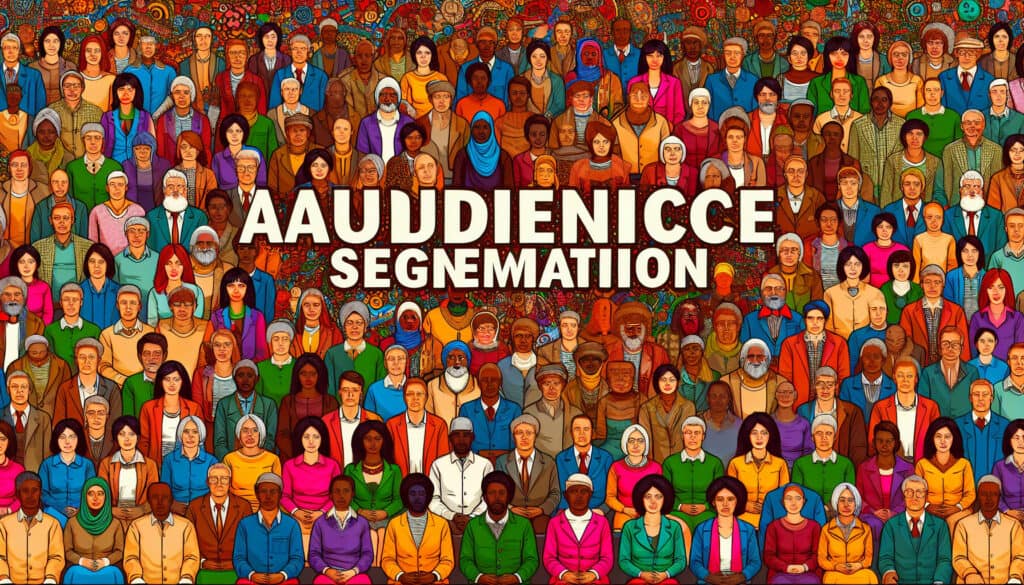The process of dividing a broad target audience into smaller, more defined groups of consumers who have similar needs, interests, and priorities.
- Metodologías: Lean Sigma, Fabricación
Segmentación de la audiencia

Segmentación de la audiencia
- Experiencia del cliente, Trayectoria del cliente, Estudios de mercado, Marketing, Estrategia de comercialización, Público destinatario, Experiencia de usuario (UX), Diseño centrado en el usuario, Propuesta de valor
Objetivo:
Cómo se utiliza:
- Audience segmentation is used to create more targeted and effective marketing campaigns. By understanding the different needs of different segments, marketers can tailor their messaging and offers to each segment.
Ventajas
- Improves marketing effectiveness, increases customer engagement, and helps to develop a deeper understanding of the target audience.
Contras
- Can be time-consuming, requires a good understanding of the target audience, and can be difficult to create segments that are both meaningful and actionable.
Categorías:
- Clientes y marketing
Ideal para:
- Creating more targeted and effective marketing campaigns by dividing the audience into smaller groups.
Audience segmentation plays a significant role in various phases of product development, particularly during the research and concept design stages. In industries such as consumer electronics, automotive, and healthcare, understanding different audience segments allows teams to prioritize features and functionalities that resonate with specific user groups. For instance, a tech company might segment their audience based on usage patterns, leading to the development of user-friendly interfaces for less tech-savvy customers while incorporating advanced features for power users. Segmentation can be initiated by marketing teams but requires collaboration with product designers, engineers, and user experience specialists. Effective segmentation relies on data analysis methods such as surveys, focus groups, and user analytics, which shed light on the preferences and expectations of each segment. This collaborative approach not only informs marketing campaigns but also influences design decisions, ensuring that products align with the distinct needs of each audience group. In the context of new product launches, such methodologies lead to reduced risks of market failure and enhanced customer satisfaction, as products are better aligned with the desires and pain points of various market segments.
Pasos clave de esta metodología
- Define segmentation objectives based on specific marketing goals.
- Identify key characteristics that will be used for segmentation, such as demographics, behaviors, and preferences.
- Select appropriate segmentation criteria that best categorize the audience.
- Segment the audience into distinct groups based on the identified criteria.
- Analyze each segment to understand their unique needs and motivations.
- Develop targeted messaging and offers for each audience segment.
- Implement marketing strategies tailored to each segment.
- Monitor and evaluate the effectiveness of the segmented campaigns.
- Refine segments and strategies based on performance data and feedback.
Consejos profesionales
- Utilize advanced analytics and machine learning algorithms to uncover latent patterns and preferences within your audience segments.
- Conduct qualitative research, such as focus groups, to understand the emotions and motivations behind the behaviors of different segments.
- Regularly revisit and refine segmentation criteria using real-time data to adapt to shifts in consumer behavior and market dynamics.
Leer y comparar varias metodologías, recomendamos el
> Amplio repositorio de metodologías <
junto con otras más de 400 metodologías.
Sus comentarios sobre esta metodología o información adicional son bienvenidos en la dirección sección de comentarios ↓ , así como cualquier idea o enlace relacionado con la ingeniería.
Contexto histórico
1960
1980
1983
1990
1995
2000
2010
1950
1980
1980
1986
1994
1995
2000
(si se desconoce la fecha o no es relevante, por ejemplo "mecánica de fluidos", se ofrece una estimación redondeada de su notable aparición)














Publicaciones relacionadas
Programa Maestro de Producción (MPS)
Personalización masiva
Embudo de marketing
Auditoría de marketing
Índice MAPO (Movimiento y Asistencia de Pacientes Hospitalizados)
Planificación de recursos de fabricación (MRP II)